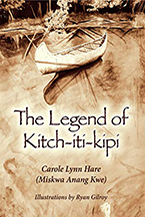November 6, 2020
The Legend of Kitch-iti-kipi
Carole Lynn Hare
Carole Lynn Hare (2020)
ISBN: 978-0-578-78251-5
New Book Reveals True Ojibwe Legend of U.P. Freshwater Spring Kitch-iti-kipi
 Just outside the town of Manistique, in Michigan’s beautiful Upper Peninsula, is Kitch-iti-kipi, Michigan’s largest freshwater spring. In the Ojibwe language, kitch-iti-kipi means “Big Spring,” and it is not only a natural wonder but a tourist attraction.
Just outside the town of Manistique, in Michigan’s beautiful Upper Peninsula, is Kitch-iti-kipi, Michigan’s largest freshwater spring. In the Ojibwe language, kitch-iti-kipi means “Big Spring,” and it is not only a natural wonder but a tourist attraction.
While Kitch-iti-kipi was long known by the Ojibwe, because it is hidden deep in the woods near Indian Lake, twelve miles outside of Manistique, it did not become popular among white locals and visitors until the 1920s when John I. Bellair, owner of a dime store in Manistique, began to popularize it. Bellair promoted several different legends about Kitch-iti-kipi to get people to visit the area. However, as he admitted later in life, he created many of those legends himself.
However, U.P. author Carole Lynn Hare knows the true legend of Kitch-iti-kipi. In her new book, The Legend of Kitch-iti-kipi, she shares an authentic Ojibwe story that has been passed down in her Ojibwe family from her great-great-great-grandmother, who repeated the tale as she first heard it from an old Ojibwe woman.
The true legend of Kitch-iti-kipi is generations and perhaps centuries old and seems to date to before European settlers arrived in the Upper Peninsula. It tells the story of a young Ojibwe warrior, Young Eagle, and the beautiful maiden, Little Fawn, who won his heart. It is also a tale of treachery, spirits, unexplainable phenomena, tragedy, and everlasting love.
Hare captures in her words the atmosphere of the time and place as well as the emotions of the characters. Her skillful storytelling is accompanied by a half-dozen black-and-white pencil illustrations by Ryan Gilroy. Like Hare, Gilroy is a native of the Manistique area. His illustrations capture the tone and tragedy of the story.
An additional nice bonus is the inclusion of a poem by Hare’s great-great-aunt Pearl about Kitch-iti-kipi. Aunt Pearl had been the first person in the family to write down the legend of Kitch-iti-kipi in a small booklet in the 1960s that the family found upon her death.
It is vitally important that we preserve oral traditions and U.P. legends before they vanish, so I applaud Hare for sharing this tale with us. That the legend of Kitch-iti-kipi has survived for generations is a testament to its power, and anyone who visits Kitch-iti-kipi will enjoy learning of the mysterious events that happened there. This little book will provide entertainment to young and old alike. The tale of Young Eagle and Little Fawn is not one you will soon forget.
For more information about Carole Lynn Hare and The Legend of Kitch-iti-kipi, visit www.CaroleHare.com.
— Tyler R. Tichelaar, PhD and award-winning author of Kawbawgam: The Chief, The Legend, The Man

